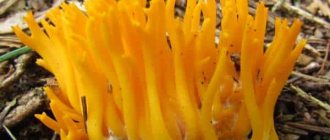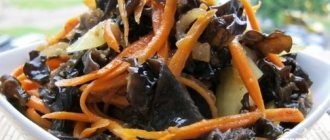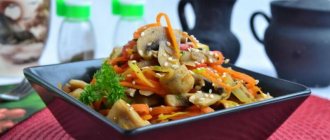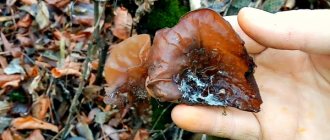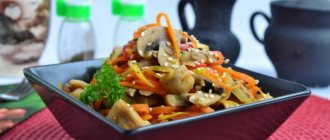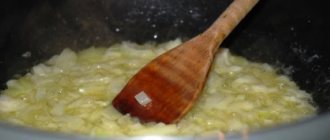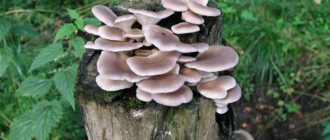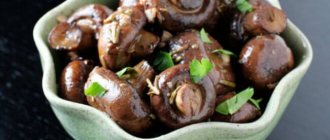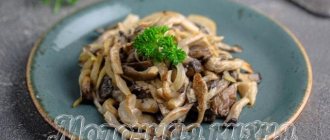The coral mushroom is a rather rare specimen, which many would avoid due to its unusual appearance. It reaches a size of up to 40 centimeters and resembles corals. Despite the fact that outwardly it does not inspire confidence in everyone, it has no poisonous counterparts, so you can collect the mushroom without fear.
Various dishes are prepared from blackberry, as this species is also called, from salads to soups. It has an almost neutral taste and a barely perceptible aroma, but when properly prepared it perfectly diversifies the everyday menu.
Coral mushrooms: benefits and harm
Coral mushroom has many popular names: gelatinous, silver ear, icy, royal, trembling, snowy. All these are alternative names, and the real (scientific) name sounds like “fuchsian tremella” (tremella fuciformis).
The coral mushroom was first described by the Englishman Joseph Berkeley back in 1856. However, the Asian world learned about it much earlier. Local herbalists sold white coral mushroom as a miracle cure for colds. It was also an excellent tonic. Transliteration of Chinese characters leads to another interesting name: “snow tree ear”, and in the Japanese version - “tree white jellyfish”.
Coral mushroom is quite nutritious. It contains about 70% dietary fiber, 18 amino acids, vitamins, carbohydrates, proteins, minerals, and plant glycogens. For many centuries, coral mushroom was used by the Chinese in the treatment of tuberculosis, colds, and hypertension.
Recent studies by scientists from Ukraine and Israel have confirmed: tremella fuchsoidum can increase immunity, protect against radiation, strengthen the respiratory system, improve hematopoiesis, and reduce cholesterol levels. Moreover, coral mushroom has anti-allergic and anti-inflammatory properties. It prevents the development of tumors and neurological damage, protects the liver from toxins, has a positive effect on the brain, and improves memory.
The enormous value of the mushroom lies in the presence of glycogens (special polysaccharides), which are prescribed by doctors for immunodeficiency, severe stress, and premature aging. The combination of nutritional properties makes it ideal for smokers.
Due to the content of natural vitamin D, coral (white) mushrooms rejuvenate the skin, accelerate metabolism, and increase blood flow in the skin cells. Important: Tremella fuchsoides is strictly contraindicated for those patients who are taking (or have just finished taking) anticoagulants. The coral mushroom has practically no independent taste. Tremella's popularity is due to its crunchy, firm, yet tender texture. Many soups, salads and even desserts are prepared from it. In powder form, coral mushroom is added to drinks and ice cream.
The Chinese way of preparing one of the sweet dishes based on this mushroom is very interesting: tremella is boiled, then dried and soaked in sweet peach syrup.
Dried “silver ear” needs additional processing. First, the product is poured with warm water for a couple of hours until it swells (increases tenfold), then it is washed and, after the excess water has drained, it is divided into small inflorescences (hard areas are removed). After this, you can start cooking. Once upon a time, the coral mushroom was so rare that only the very rich could afford it. Now tremella is grown on an industrial scale and is quite affordable for the average buyer. You can see it in most Asian grocery stores.
Coral mushroom is stored in the refrigerator in tightly closed, airtight containers.
Useful properties and restrictions on use
Ice mushrooms are rich in vitamins, so they are often used in areas such as medicine and cosmetology. In medicine, they act as natural antibiotics and antidepressants; medications are made from them, thanks to which the body produces antibodies that destroy viruses and bacteria.
In addition, they are recommended for use in Alzheimer's disease. Chinese medicine includes their use as a treatment for tumors and a source of vitamins during the recovery period after chemotherapy. These mushrooms are also recommended for consumption in cases of nervous disorders and immunodeficiency.
Other useful properties are represented by the ability to:
- lowering cholesterol levels;
- relieving inflammation;
- reducing exposure to radiation;
- removal of toxins;
- liver protection.
Despite the many positive effects these mushrooms have, there are a number of restrictions on their consumption:
- Tendency to allergic reactions.
- Use in a mono-diet. Due to the high protein content in this product, changes in metabolism and disruption of oxidative processes are possible. Their use in the diet should be moderate.
Rogatik reed - It is undesirable to eat mushrooms collected in areas with unfavorable environmental conditions. They easily absorb harmful substances, so collecting them and using them in cooking is not worth it.
- They are strictly contraindicated for use by people with pancreatitis, dysbiosis and individual intolerance. They are not advisable in the diet of children under 14 years of age, since their enzymatic system has not yet fully formed.
The maximum frequency of using mushrooms in the diet for a healthy person is three times a week in moderate quantities.
You may be interested in:
What does the greenfinch mushroom look like and its description (16 photos) The Ryadkov family (or Tricholomovaceae) has up to 2500 species of mushrooms, among which the mushroom is very well known...Read more...
Corals in Korean
Dry corals - 4 pcs.
- Garlic -5 cloves
- seasoning for korean dishes
- salt, sugar.
Step-by-step cooking recipe:
Place the corals in an enamel bowl and pour boiling water over them so that it covers all the mushrooms.
Add salt, sugar. And leave for 30 minutes. The mushrooms increase in size very much, so don’t be greedy (about 5 times).
Rinse under cold water. Rinse thoroughly, a lot of sand and some kind of dirt
Chop mushrooms and add dressing
Add crushed garlic through a garlic press, salt, sugar to taste. Leave to marinate for 1.5 hours. Bon appetit!
Growing at home and in the country
Stores specializing in garden products sell wooden sticks with spores. In open ground, planted from April to October. They can grow in a greenhouse all year round. The estimated price of mycelium with spores is $4.
The spores are placed in the wood. To start, take freshly cut logs, without shoots. The recommended diameter is 20 cm, length is at least a meter. Immerse the sticks in water, after making holes in them (up to 4 cm), measuring 10 cm each time. To make the spores sprout more actively, create a greenhouse effect: wrap the log with film, take it to a warm, dark room. Watering should be done twice a week.
Note! Before working with spores, wear sterile gloves or treat your hands with an antiseptic. The log can be brought into the light after the mycelium appears
When the temperature drops in the winter, cover with film. How many days does it take to collect the fruits of your labor? The first harvest appears 6 months after planting. Mushrooms are cut at a young age, without waiting for the color and texture to change
The log can be brought into the light after the mycelium appears. When the temperature drops in the winter, cover with film. How many days does it take to collect the fruits of your labor? The first harvest appears 6 months after planting. Mushrooms are cut at a young age, without waiting for the color and texture to change.
Ice (coral) marinated mushroom in Korean style
11/17/2016 Author: Victoria
When I came across this snack at the market in the Chinese snacks section, I, like many other buyers, was confused for a long time. I always thought that this was algae))) It turns out that this is a Chinese tree mushroom))) After a long time, I found it in dried form in the supermarket, like soy meat and asparagus. Having bought some to try, I decided to take a chance and made it at home. In the post - that's it!!! Tasty, nutritious, unusual! And not only in Lent. We will need:
- 1-3 pcs. ice mushroom 1 liter boiling water 3 tbsp. soy sauce 1 tsp. honey (optional) or 1 tsp. sugar ground black pepper, paprika, you can use seasoning for funchose or Korean carrots 2 cloves of garlic
Place the mushrooms in a wide saucepan and add boiling water until it completely covers the mushrooms. Let stand for about 30 minutes. Then rinse, as the mushrooms may contain sand. Remove the hard part. Divide the mushroom that has increased in volume into small parts. Place in a cup with a lid. Pour soy sauce into a saucepan, add honey or sugar and spices, squeeze the garlic through a press. Heat until honey or sugar is completely dissolved. Pour this marinade over the mushrooms, mix well and marinate for 3-4 hours, or preferably overnight. Bon appetit!
Calorie content, composition and taste assessment
The calorie content in ice mushroom is 76 kcal per 100 grams - this is 4% of the daily value of a healthy person. Chemical composition of ice mushroom (also called coral mushroom):
- carbohydrates – 6 g;
- proteins – 1.8 g;
- fats – 4.3 g.
Ice mushrooms contain dietary fiber (70%), proteins, carbohydrates, vitamin D, 18 valuable amino acids, 3/4 of which are essential for the human body, beneficial minerals and plant glycogens (trehalose, mannitol and pentosan). Tremella contains a lot of phosphorus, calcium, magnesium, sodium and sulfur.
Reference! The vitamin D content in coral mushrooms is greater than in cod liver, tuna, salmon, shrimp and sunflower oil combined.
Tremella fucus is a delicacy. It has the amazing property of changing its taste depending on the place where it grows.
For example, if tremella grows in mango thickets, then the fruiting bodies will have a pine, honey flavor, if in an oak grove, then a light woody aroma.
Comb blackberry. Medicinal properties of blackberries
All types of this mushroom have been studied in scientific laboratories for their medicinal properties. And the following became clear.
- Coral blackberry is a potential cure for Alzheimer's disease and a good anthelmintic.
- Variegated blackberry - lowers cholesterol, suppresses the uncontrolled growth of cancer cells, and is a strong immunomodulator.
- White and yellow blackberries - significantly slow down the growth of cancer cells (sarcoma, carcinoma, stomach cancer), destroy staphylococci and bacteria that cause stomach and duodenal ulcers, and reduce cholesterol levels.
- Comb blackberry - has hypoacid properties, protects the gastric mucosa in case of increased acidity of gastric juice, heals wound surfaces and ulcerations of the stomach and intestines, suppresses the activity of pathogenic bacteria and fungi, and is an effective antitumor agent (pancreatic cancer).
Sparassis curly - description of where it grows, the toxicity of the mushroom
Sparassis curly is understood in the literal sense of the word as a curly beige mushroom, which is classified as a member of the Sparass family. There are no more than 7 varieties in this family, which is remarkable. The mushroom is an edible and very tasty variety, but it is listed in the Red Book of our country as an endangered type. Due to deforestation and human gathering, the number of specimens presented is decreasing. Today we will study everything connected with them.
Description
Let us repeat once again that this variety is classified as edible. The mushroom attracts attention, first of all, because it is famous for its external characteristics. In common parlance it is called by many different names, including mushroom cabbage, lamb mushroom, mushroom happiness, as well as hare cabbage and king mushroom. Moreover, the name “lamb” is used only in foreign reference materials; our compatriots practically do not express it this way. Russian experts by lamb mean a completely different mushroom - curly griffola. Now consider the description of the presented intricate specimen. The fruiting body consists of multiple curly leaves that branch and look like a shrub.
The mushroom is quite large; its wrinkled lobes with wavy edges cannot go unnoticed. Considering the diameter, we can say that some fruiting bodies grow up to 20-60 cm. Of course, this is rare; on average, mushrooms with a diameter of 7-30 cm are found. The height of the bush is about 20 cm, and its weight exceeds 6-8 kg . Some mushroom pickers came across specimens weighing 10-14 kg. The fruit bodies are beige, yellow-white in color. Mature specimens have a dark, brownish color with reddish splashes. The base is poorly visible, it is root-like, attached to the center of the body.
The thickness of the leg is about 5 cm, for the most part it is dug into the ground, so it is not visible. It grows up to 13 cm in length, is colored white-yellow, and can darken and turn black when overripe. The soft part of the peculiar wavy blades is fragile, easily crumbles and breaks. In mature fruiting bodies it is tough and hard. It tastes nutty and smells strange. The smell has nothing to do with mushroom aroma. Reproduction is carried out by elliptical-shaped spores; they are light yellow or white in color. The layer, otherwise called spore-bearing, prefers to be located on each blade. Moreover, it occupies only one side, without completely wrapping around. In hue, this layer is pigmented creamy white or gray. Feels a little rough, maybe too smooth.
Interesting Facts
- Snow mushroom is one of the best-selling mushrooms in the world. The average turnover of its sales is 130 tons.
- 100 years ago, ice cream was used in China as an excellent cough remedy. It was dried, crushed and brewed as tea. The medicine was very expensive for ordinary people, so they began to grow the mushroom at home.
- The ice mushroom's favorite place to grow is oak sticks.
Coral mushrooms are quite unusual species in nature, many of them have become rare and are listed in the Red Book. If you are lucky enough to find one of these specimens in the forest, do not rush to tear it off completely, leave some to nature. Please note that tremella can be bred at home, and some entrepreneurs have made tremella cultivation a source of income. Having such a wonderful healing mushroom in your own garden is a great success.
Urticaria is an unusually shaped mushroom
The tendril has the appearance of a tiered, fleshy, wavy mushroom with numerous hanging mustaches of white-cream or white color. The caps of barnacle hedgehogs often grow sideways. The height of the fruiting body reaches 15 centimeters, and the diameter can be 20 centimeters.
Thanks to its fan-shaped shape, the mushroom looks very unusual. The antennal hedgehog generally does not have a cap or legs, and the hanging antennae look like waves. Thanks to this feature, tendrils have no common similarity with ordinary types of mushrooms.
The color of the cap is pinkish, the edges are raised. The color of the edges can be reddish or have a coral tint, making the mushroom easy to see in the forest. The hymenophore is formed by long, thick, soft, conical needles.
The pulp of the barnacle is fleshy, cotton-like, it tastes pleasant with a good aroma. Places of growth and fruiting time of barnacle grass
These mushrooms grow on tree trunks. They can be seen on stumps and trunks in mixed forests. Antennae hedgehogs prefer damp places. They are rare on the ground, but on trees they grow in clusters, intertwined into beautiful inflorescences.
